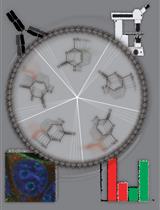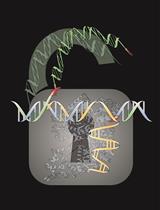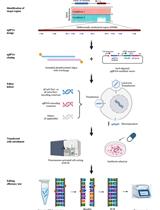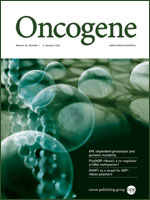- Submit a Protocol
- Receive Our Alerts
- Log in
- /
- Sign up
- My Bio Page
- Edit My Profile
- Change Password
- Log Out
- EN
- EN - English
- CN - 中文
- Protocols
- Articles and Issues
- For Authors
- About
- Become a Reviewer
- EN - English
- CN - 中文
- Home
- Protocols
- Articles and Issues
- For Authors
- About
- Become a Reviewer
DNA Methylation Profiling Using Infinium Methylation Assay
Published: Vol 3, Iss 10, May 20, 2013 DOI: 10.21769/BioProtoc.777 Views: 15756
Reviewed by: Lin Fang

Protocol Collections
Comprehensive collections of detailed, peer-reviewed protocols focusing on specific topics
Related protocols

In situ Quantification of Cytosine Modification Levels in Heterochromatic Domains of Cultured Mammalian Cells
María Arroyo [...] Florian D. Hastert
Jul 20, 2023 1698 Views

Efficient Large DNA Fragment Knock-in by Long dsDNA with 3′-Overhangs Mediated CRISPR Knock-in (LOCK) in Mammalian Cells
Wenjie Han [...] Jianqiang Bao
Oct 20, 2023 2739 Views

CRISPR/dCas9-Tet1-Mediated DNA Methylation Editing
Junming Qian and Shawn X. Liu
Apr 20, 2024 4041 Views
Abstract
The Infinium Human Methylation 450 BeadChip technology allows the rapid quantitative DNA methylation analysis of more than 485,000 CpG dinucleotides located across the genome. The method utilizes sodium bisulfite treatment of genomic DNA to convert unmethylated cytosine residues into uracils whereas methylated cytosines remain unchanged. Modified DNA is then whole genome amplified, fragmented and hybridized to locus-specific oligomer probes linked to individual beads on a BeadChip. Hybridization is followed by single-base extension of the oligomer with a labeled nucleotide. The BeadChip is subsequently fluorescently stained and scanned to measure the intensities of the beads corresponding to the unmethylated and methylated CpG sites.
Keywords: EpigeneticsMaterials and Reagents
- EZ-96 DNA Methylation Kit (Zymo Research, catalog number: D5003 )
- Ethanol (VWR International, catalog number: 20821.330 )
- Genomic DNA
- PCR Grade water (Life Technologies, InvitrogenTM, catalog number: AM9937 )
- PCR reagents: PCR buffer, dNTPs, Taq (Roche Applied Science, catalog number: 04738420001 )
- Primers for methylation specific PCR [see Step 20-(1)]
- 96-well 0.2 ml microplates (Starlab, catalog number: I1402-9800-C )
- 96-well 0.8 ml microplates (Thermo Fisher Scientific, catalog number: AB-0765 )
- Seal sheets (Thermo Fisher Scientific, catalog number: AB-0558 )
- Infinium Human Methylation450 BeadChip Kit (Illumina, catalog number: WG-314-1003 )
- PyroMark Q96 CpG LINE-1 Kit (QIAGEN, catalog number: 973043 ) and associated reagents (Optional)
Equipment
- 96-well Thermal Cycler
- Centrifuge with microplate adapters
- Vortex mixer
- HiScan SQ or iScan systems (Illumina, catalog number: SY-103-2001 or SY-101-1001 respectively)
- GenomeStudio Methylation Module software (Illumina, catalog number: SW-300-1001 )
- NanoDrop ND-1000 UV-Vis spectrophotometer (Thermo Fisher Scientific) or equivalent
- Speed Vacuum (Optional)
- PyroMark Q96 MD (QIAGEN, catalog number: 9001526 ) or equivalent (Optional)
Procedure
- Quantitate genomic DNA concentration using NanoDrop and determine A260/280 ratio which should be > 1.80 for samples to be analyzed.
- Dilute each DNA sample in water to 100 ng μl-1 concentration.
Note: It is also possible to use samples at lower concentrations and adjust the volumes in step 6 accordingly to meet the minimum quantity of DNA required. However, volumes of DNA samples with lower concentrations used in step 6 should not exceed a maximum volume of 45 μl.
Note: Once DNA is bisulfite treated it should be used for Infinium Methylation analyses as soon as possible, preferably within one month. - Prepare Conversion Reagent from EZ96 DNA Methylation Kit by adding 7.5 ml water and 2.1 ml of M-Dilution buffer to a bottle of CT Conversion Reagent. Mix at room temperature with frequent vortexing for 10 min and keep reagent in dark.
Note: It is normal to see trace amounts of undissolved CT Conversion Reagent. Also, for best results the reagent should be immediately used after preparation. - Prepare M-Wash Buffer from EZ96 DNA Methylation Kit by adding 144 ml 100% ethanol to the 36 ml M-Wash Buffer concentrate.
- Pipet 10 μl of each DNA sample (100 ng μl-1) into a 96-well 0.2 ml microplate for bisulfite treatment (500 ng is the minimum quantity of DNA used).
- Add 5 μl of M-Dilution buffer to each sample and adjust the total volume to 50 μl with water and mix by pipetting up and down. Seal with seal sheet.
- Incubate samples at 37 °C for 15 min using thermal cycler.
- Add 100 μl of the prepared CT Conversion Reagent to each sample and mix by pipetting up and down several times. Seal plate with a seal sheet.
Note: CT-Conversion Reagent contains 97% Sodium Metabisulfite (bisulfite ions) which mediates bisulfite-mediated deamination of unmethylated Cytosine. - Incubate samples on thermal cycler using the following program
- 95 °C for 30 sec.
- 50 °C for 1 h and repeat steps a and b for 15 more cycles.
- 4 °C for 10 min.
- 95 °C for 30 sec.
- From EZ96 DNA Methylation Kit, place Silicon-A Binding Plate on top of Collection Plate and pipette 400 μl of M-Binding Buffer to each well. This buffer contains guanidine hydrochloride salt which provides pH that enables DNA to bind to the silica particles and allows washing and bisulfite treatment of the DNA.
- Load the DNA samples from step 10 into the wells of the Silicon-A Binding Plate and mix by pipetting up and down.
- Centrifuge at room temperature at ≥ 3,000 x g for 5 min and discard the flow-through. Use this condition for all centrifugation steps in this protocol.
- Add 500 μl of M-Wash buffer to each well and centrifuge at ≥ 3,000 x g for 5 min. Discard the flow-through. M-Wash buffer is to wash and clean any reagent from silica-bound DNA from previous step.
- Add 200 μl of M-Desulphonation buffer to each well and let it stand at room temperature for 15-20 min. After incubation centrifuge at ≥ 3,000 x g for 5 min. Discard the flow-through. M-Desulphonation buffer contains sodium hydroxide which converts deaminated cytosines to Uracil.
- Add 500 μl of M-Wash buffer to each well and centrifuge at ≥ 3,000 x g for 5 min. Discard the flow-through.
- Add another 500 μl of M-Wash buffer to each well and centrifuge at ≥ 3,000 x g for 10 min. Ensure there is no liquid left in the wells of Silicon-A binding Plate, otherwise centrifuge for further 2 min.
- Place Silicon A Binding Plate onto an elution plate.
- Add 30 μl of M-Elution buffer directly to the binding matrix in each well of Silicon A Binding Plate. Incubate for 1-2 min at room temperature and centrifuge for 3 min at ≥ 3,000 x g to elute the DNA. M-Elution buffer contains 1% Tris (hydroxymethyl) aminomethane/Hydrochloric Acid and 1% Ethylenediaminetetraacetic Acid, pH 8.0 which enables dissociation of DNA from silica column.
- Keep aside 4 μl of each (bisulfite converted) DNA sample for quality control and store remaining amount in the elution plate at -20 °C.
Note: It is recommended to use bisulfite converted samples on the Infinium HumanMethylation450 BeadChip within 1 month of conversion and to avoid repeated freeze-thaw cycles of samples. - Assess the quality of bisulfite converted DNA by using for instance methylation-specific PCR (Ku et al., 2011) for gene of interest (see Note below for an example of our Methylation-specific PCR for Calponin gene) or using pyrosequencing of LINE1 with PyroMark Q96 CpG LINE-1 kit. Proceed with DNA samples which have passed quality control, i.e. samples which either show a PCR product with methylation specific PCR or have passed the bisulfite modification control contained within the LINE1 pyrosequencing assay.
Notes:
- Methylation-specific PCR for Calponin gene for assessing quality of bisulfite treated DNA:
Mix 15.8 μl water with
2.5 μl 10x PCR buffer
3 μl MgCl2 (25 mM)
0.5 μl dNTPs (2.5 mM)
1 μl Forward Primer (5′-GGAAGGTAGTTGAGGTTGTG-3′, 20 μM)
1 μl Reverse Primer (5′-CCCAAACTCAAAACTCTAACCTAAC-3′, 20 μM)
1 μl Bisulfite converted DNA
0.2 μl Taq (5 U)
- PCR conditions:
95 °C for 6 min
95 °C for 30 sec
63 °C for 30 sec
72 °C for 30 sec
Repeat steps b to d for 35 cycles
72 °C for 5 min.
Run PCR products on a 2% agarose gel to confirm presence of amplicons (333 bp) which verify that the bisulfite conversion has been successful in respective samples. (Teodoridis et al., 2005)
- Methylation-specific PCR for Calponin gene for assessing quality of bisulfite treated DNA:
- Determine concentration of bisulfite treated DNA using NanoDrop.
Note: As the bisulfite treatment can degrade DNA samples, we have additional DNA quantitation step here after the bisulfite treatment in our protocol, to ensure that there is sufficient sample present before proceeding to Infinium Methylation analyses. - Thaw DNA samples stored at -20 °C and briefly centrifuge. Adjust DNA concentration of each sample to 50 ng μl-1 with M-Elution buffer or water.
Note: DNA samples below 50 ng μl -1 may be concentrated using speed vacuum. - Transfer 6 μl of each 50 ng μl-1 sample to a new 0.8 ml 96-well microplate which is labeled as BCD plate in the Infinium HD Assay Methylation Protocol.
- Process 4 μl (or equivalent of 200 ng) samples according to Infinium HD Assay Methylation Protocol Guide (see Reference 3), starting from step 3, page 43 (under steps to make MSA4 plate). Briefly, bisulfite converted DNA is whole genome amplified, fragmented and hybridized to the BeadChip. Following hybridization, unhybridized DNA is washed off and probes on the BeadChip are extended using a labeled nucleotide and captured DNA as a template. The BeadChip is fluorescently stained, scanned and the intensities of beads are measured.
- Following processing, extract DNA methylation signals from scanned arrays.
- Background correct raw signals and compute into β value using the GenomeStudio software.
- Before proceeding to data analysis, perform quality control using the GenomeStudio Software. Data quality can be assessed by checking the detection p-value of probes as well as the sample-dependent and sample-independent control probes which are present on the BeadChips. The following criteria are applied for removal of poorly performing probes or samples: a) probes with a detection p-value above a certain cut-off (e.g. p < 0.05) should be excluded from the analysis, b) samples which fail in any of the array control probes i.e. the raw signal intensities of the control probes of the sample are out of normal range (median+3SD or median-3SD depending on the control probe type) of the signal intensities across all the samples and c) if a certain probe has failed quality control via the detection p-value in greater than 10-25% of samples, then that probe should be removed from further downstream analyses.
- An appropriate method of within and between array normalization should be performed. For instance the Genome studio software provides an internal control normalization procedure.
- The Infinium 450 K BeadChips use two different types of assay chemistries (Infinium I and Infinium II probes). The β value represents either the ratio of the intensity of the methylated bead type to the combined locus intensity (Infinium type 1 probes) or the ratio of the intensity of the signal from the green channel (corresponding to the methylated CpG state) to the combined intensity obtained from red and green channels (Infinium type II probes) and reflects the methylation status of the specific CpG site. Due to the divergent chemistries of Infinium I and II probes which result in different β value distributions it is recommended to perform peak base correction or the scaling of probes to more accurately reflect the divergent distributions of type I and II probes. Different peak base correction methods are publicly available; see for instance in (Teschendorff et al., 2013).
Acknowledgments
This work was supported by grant awards from Cancer Research UK (C536/A6689), Imperial Experimental Cancer Medicine Centre and Imperial Cancer Research UK Centre.
References
- Dedeurwaerder, S., Defrance, M., Calonne, E., Denis, H., Sotiriou, C. and Fuks, F. (2011). Evaluation of the Infinium Methylation 450K technology. Epigenomics 3(6): 771-784.
- EZ-96 DNA Methylation Kit D5003 Instruction Manual Version 1.2.6, Zymo Research.
- GenomeStudio Methylation Module v1.8 User Guide, Catalog number # 11319130 Rev. B November 2010, Illumina.
- Infinium HD Assay Methylation Protocol Guide, catalog number: WG-914-1001Pat # 15019519 Rev. A December 2010, Illumina.
- Ku, J. L., Jeon, Y. K., Park, J. G. (2011). Methylation-specific PCR. Methods Mol Biol 791:23-32.
- PyroMark Q96 CpG LINE-1 Handbook 12/2010, Qiagen.
- Sriraksa, R., Chaopatchayakul, P., Jearanaikoon, P., Leelayuwat, C. and Limpaiboon, T. (2010). Verification of complete bisulfite modification using Calponin-specific primer sets. Clin Biochem 43(4-5): 528-530.
- Teschendorff, A. E., Marabita, F., Lechner, M., Bartlett, T., Tegner, J., Gomez-Cabrero, D., Beck, S. (2013). A Beta-Mixture Quantile Normalisation method for correcting probe design bias in Illumina infinium 450k DNA methylation data. Bioinformatics 29 (2): 189-196.
- Teodoridis, J. M., Hall, J., Marsh, S., Kannall, H. D., Smyth, C., Curto, J., Siddiqui, N., Gabra, H., McLeod, H. L., Strathdee, G. and Brown, R. (2005). CpG island methylation of DNA damage response genes in advanced ovarian cancer. Cancer Res 65(19): 8961-8967.
- Touleimat, N. and Tost, J. (2012). Complete pipeline for Infinium((R)) Human Methylation 450K BeadChip data processing using subset quantile normalization for accurate DNA methylation estimation. Epigenomics 4(3): 325-341.
- Zeller, C., Dai, W., Steele, N. L., Siddiq, A., Walley, A. J., Wilhelm-Benartzi, C. S., Rizzo, S., van der Zee, A., Plumb, J. A. and Brown, R. (2012). Candidate DNA methylation drivers of acquired cisplatin resistance in ovarian cancer identified by methylome and expression profiling. Oncogene 31(42): 4567-4576.
Article Information
Copyright
© 2013 The Authors; exclusive licensee Bio-protocol LLC.
How to cite
Zeller, C., Masrour, N., Patel, N., Dai, W., Wilhelm-Benartzi, C. and Brown, R. (2013). DNA Methylation Profiling Using Infinium Methylation Assay. Bio-protocol 3(10): e777. DOI: 10.21769/BioProtoc.777.
Category
Systems Biology > Epigenomics > DNA methylation
Molecular Biology > DNA > DNA modification
Do you have any questions about this protocol?
Post your question to gather feedback from the community. We will also invite the authors of this article to respond.
Share
Bluesky
X
Copy link








